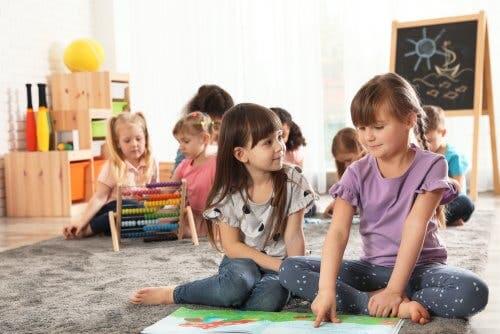How to Instill a Growth Mentality in Children

Children have two ways of thinking, which many pedagogical theories clearly differentiate. We have both a fixed mentality and a growth mentality that are easy to distinguish. One of the challenges that educators face today is instilling a growth mentality in children.
People who have a growth mentality believe they’re capable of learning and can improve their abilities. As a result, challenges provide opportunities to grow, and mistakes are opportunities to learn. Problems take on a new meaning because of the lessons they provide. These people firmly believe they can obtain what they want by dedicating the necessary time and effort. They go after their goals and work towards them.
Growth mentality is an unexplored territory in many educational environments. Understanding it and seeking it in students in an effective way is one of the great priorities in teaching today.
This relatively new pedagogy focuses on helping students understand values like effort and persistence. It also seeks to test new methods of learning in order to maximize students’ talents and abilities. Below, we’ll look at some concrete ways to instill a growth mentality in students.

Avoid praising intelligence and sheer effort
While it may sound contradictory at first, it’s important to avoid praising intelligence and effort. Rather, we should recognize the importance of planning and trying out new approaches. That way, we’ll reduce the risk of discouraging growth. With this in mind, we need to pay attention to the language we use.
“Our studies show that teaching people to have a growth mindset, which encourages a focus on effort rather than on intelligence or talent, helps make them into high achievers in school and in life.”
– Carol S. Dweck –
Compliments and feedback can change the way that students process learning. Therefore, the focus of these two components will determine whether or not students develop a growth mentality.
What’s more, although effort has to do with a growth mentality, explicitly praising effort can actually be counterproductive. Experts recommend that you should encourage students to search for different learning strategies.
Let’s take a look at specific examples of feedback that can either encourage a fixed mindset or a growth mindset in children:
- Incorrect (fixed mentality): You did everything you could. Don’t worry.
- Recommended (growth mentality): Don’t worry if you don’t understand everything right away. Focus on the next steps you can take. What do you think they should be?
- Incorrect (fixed mentality): Good work! You’re so smart!
- Recommended (growth mentality): Good work! The study plan you created and followed really helped you! You should do the same for your next test.
Use a variety of teaching strategies to encourage a growth mentality in children
“Exposing students to different instructional methods and strategies will help build a repertoire of learning skills to handle diverse challenges.”
– Carol Dweck –
So, we can use different teaching tactics and principles to vary the content that we present. That way, we’ll change the way students process content and knowledge.
Students should acquire an entire array of new abilities that help them approach new and diverse obstacles in learning.
- Content: When applicable, we can use videos, audio clips, presentations, and physical elements such as blocks in our lessons.
- Processes: We can give students opportunities to not only work individually but in pairs, small groups and big groups.
- Projects: We can allow students to demonstrate their understanding of content in a variety of ways on tests, projects, and assignments. For example, you can create an open project that students can complete as an essay, presentation, or artistic production.

Introduce simple elements of gamification
Certain aspects of gamification (the practice of applying video game elements to our classes) can highlight student progress instead of emphasizing mistakes. Specifically, we can easily modify how we present grades on tests and assignments.
Teach the value of challenges to encourage a growth mentality in children
Explaining the inherent benefits of overcoming obstacles can help students develop a growth mindset. This means teaching students about the effect that understanding difficult concepts has on the brain when people push through their comfort zones to grasp difficult concepts. Neurons form stronger connections, which leads to improved intelligence over time.
Therefore, effort and difficulty are paths, not obstacles, when it comes to becoming more intelligent.
Exposing this reality explicitly to students will lead them to produce better results because they’ll understand what happens internally when they make an effort. In fact, a study conducted by Carol Dweck and her colleagues proved just that.
Showing the great benefits of building a growth mentality can have a positive effect on students.
As you can see, it’s crucial that, as educators, we take the time to take our students from a fixed mentality to a growth mentality. We should remind them that it’s normal to evolve from having a fixed mentality to having a growth mentality, or vice versa. What’s more, we must help them identify the things that can cause a change in mentality.
Children have two ways of thinking, which many pedagogical theories clearly differentiate. We have both a fixed mentality and a growth mentality that are easy to distinguish. One of the challenges that educators face today is instilling a growth mentality in children.
People who have a growth mentality believe they’re capable of learning and can improve their abilities. As a result, challenges provide opportunities to grow, and mistakes are opportunities to learn. Problems take on a new meaning because of the lessons they provide. These people firmly believe they can obtain what they want by dedicating the necessary time and effort. They go after their goals and work towards them.
Growth mentality is an unexplored territory in many educational environments. Understanding it and seeking it in students in an effective way is one of the great priorities in teaching today.
This relatively new pedagogy focuses on helping students understand values like effort and persistence. It also seeks to test new methods of learning in order to maximize students’ talents and abilities. Below, we’ll look at some concrete ways to instill a growth mentality in students.

Avoid praising intelligence and sheer effort
While it may sound contradictory at first, it’s important to avoid praising intelligence and effort. Rather, we should recognize the importance of planning and trying out new approaches. That way, we’ll reduce the risk of discouraging growth. With this in mind, we need to pay attention to the language we use.
“Our studies show that teaching people to have a growth mindset, which encourages a focus on effort rather than on intelligence or talent, helps make them into high achievers in school and in life.”
– Carol S. Dweck –
Compliments and feedback can change the way that students process learning. Therefore, the focus of these two components will determine whether or not students develop a growth mentality.
What’s more, although effort has to do with a growth mentality, explicitly praising effort can actually be counterproductive. Experts recommend that you should encourage students to search for different learning strategies.
Let’s take a look at specific examples of feedback that can either encourage a fixed mindset or a growth mindset in children:
- Incorrect (fixed mentality): You did everything you could. Don’t worry.
- Recommended (growth mentality): Don’t worry if you don’t understand everything right away. Focus on the next steps you can take. What do you think they should be?
- Incorrect (fixed mentality): Good work! You’re so smart!
- Recommended (growth mentality): Good work! The study plan you created and followed really helped you! You should do the same for your next test.
Use a variety of teaching strategies to encourage a growth mentality in children
“Exposing students to different instructional methods and strategies will help build a repertoire of learning skills to handle diverse challenges.”
– Carol Dweck –
So, we can use different teaching tactics and principles to vary the content that we present. That way, we’ll change the way students process content and knowledge.
Students should acquire an entire array of new abilities that help them approach new and diverse obstacles in learning.
- Content: When applicable, we can use videos, audio clips, presentations, and physical elements such as blocks in our lessons.
- Processes: We can give students opportunities to not only work individually but in pairs, small groups and big groups.
- Projects: We can allow students to demonstrate their understanding of content in a variety of ways on tests, projects, and assignments. For example, you can create an open project that students can complete as an essay, presentation, or artistic production.

Introduce simple elements of gamification
Certain aspects of gamification (the practice of applying video game elements to our classes) can highlight student progress instead of emphasizing mistakes. Specifically, we can easily modify how we present grades on tests and assignments.
Teach the value of challenges to encourage a growth mentality in children
Explaining the inherent benefits of overcoming obstacles can help students develop a growth mindset. This means teaching students about the effect that understanding difficult concepts has on the brain when people push through their comfort zones to grasp difficult concepts. Neurons form stronger connections, which leads to improved intelligence over time.
Therefore, effort and difficulty are paths, not obstacles, when it comes to becoming more intelligent.
Exposing this reality explicitly to students will lead them to produce better results because they’ll understand what happens internally when they make an effort. In fact, a study conducted by Carol Dweck and her colleagues proved just that.
Showing the great benefits of building a growth mentality can have a positive effect on students.
As you can see, it’s crucial that, as educators, we take the time to take our students from a fixed mentality to a growth mentality. We should remind them that it’s normal to evolve from having a fixed mentality to having a growth mentality, or vice versa. What’s more, we must help them identify the things that can cause a change in mentality.
All cited sources were thoroughly reviewed by our team to ensure their quality, reliability, currency, and validity. The bibliography of this article was considered reliable and of academic or scientific accuracy.
- Carol Dweck. (2016). Mindset, la actitud del éxito. Editorial Sirio.
This text is provided for informational purposes only and does not replace consultation with a professional. If in doubt, consult your specialist.








